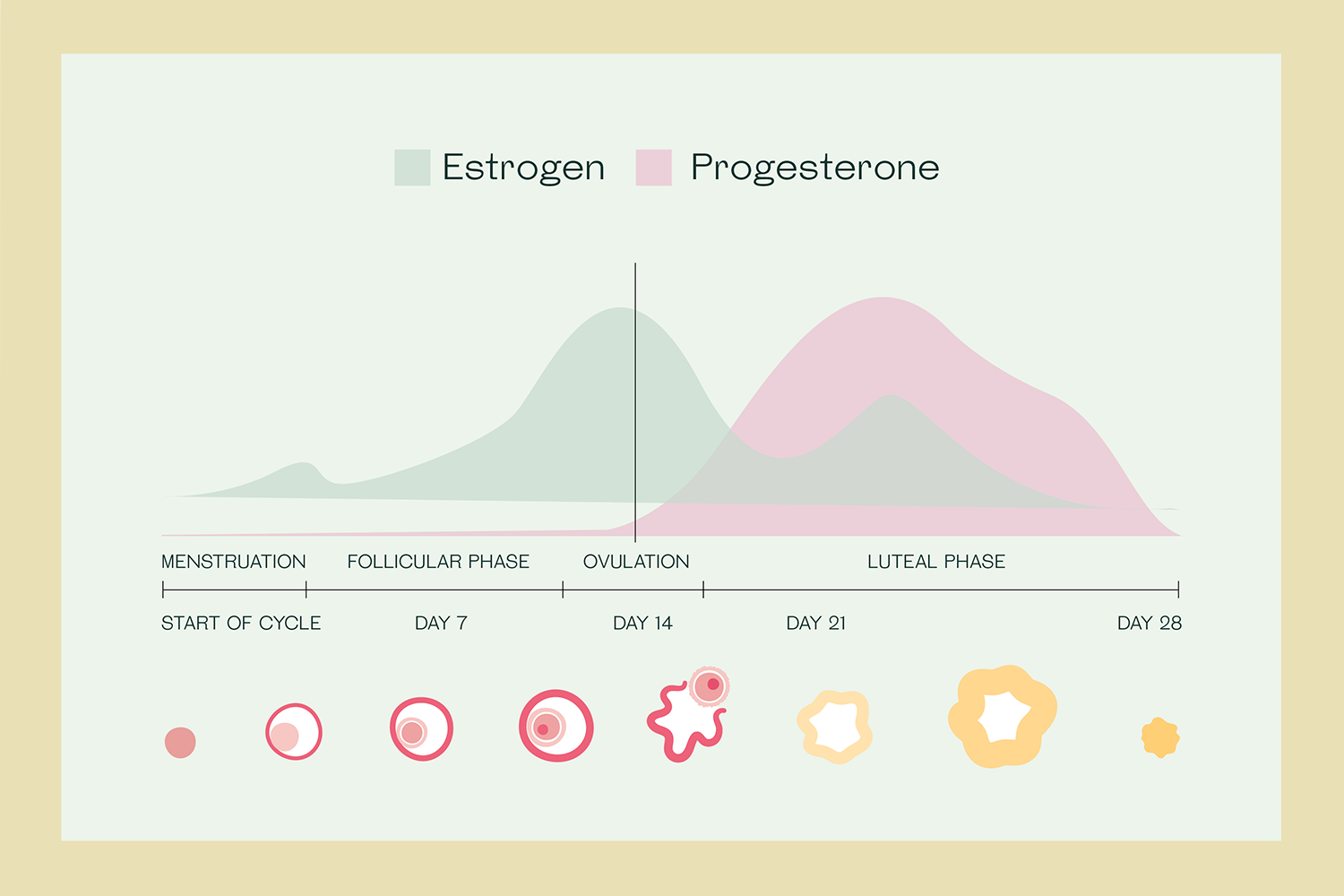Estrogen and Progesterone: Understanding the Role of Each when TTC
What are estrogen and progesterone?
The purpose of estrogen and progesterone
Production of estrogen and progesterone
Estrogen vs progesterone levels and testing
Two of the most important hormones for women are estrogen and progesterone, but there can be a lot of confusion surrounding these two hormone powerhouses. We often refer to hormones as a group because they work together and their balance is essential to good health. However, when it comes to estrogen vs progesterone, it can be helpful to look at them individually.

In this post we’ll cover what estrogen and progesterone do, where they’re produced, and how their levels impact your health.
What are estrogen and progesterone?
Hormones are the chemical messengers of the body and work by traveling through the bloodstream to deliver instructions to cells designed to receive their messages. While each hormone has a specific purpose and function, estrogen and progesterone belong to a class of hormones known as sex hormones.
These hormones impact sexual development during puberty and are involved in reproduction. They are constantly shifting through your cycle (unless you take certain types of hormonal birth control) and levels fluctuate throughout a person’s life.
In women, estrogen and progesterone are made mainly by the ovaries and influence everything from puberty and the development of breasts to the ability to become pregnant and body hair growth.
Although it’s mainly associated with menstruation, estrogen also impacts bone health, cardiovascular function, skin tissues, and brain function. Progesterone is primarily responsible for getting your body ready for pregnancy and then maintaining that pregnancy.
It’s important to note that estrogen and progesterone are not exclusive to women or people who menstruate. However, because other people may not have ovaries or have an egg being actively released every month, their hormone supply is made in other areas of the body like fat tissues or the adrenal glands.
The purpose of estrogen & progesterone
What does estrogen do?
Estrogen plays a key role in many functions throughout the body and helps develop and maintain both the reproductive system and sex characteristics like body hair and breasts. During puberty, it is responsible for female sexual development and triggers the growth of breasts, pubic hair, and other sex characteristics.
Estrogen’s key role is in enabling the functionality of sexual organs. In the ovaries, it helps stimulate the growth of the egg follicle, while in the vagina it maintains the thickness of the vaginal wall and has a role in lubrication. It’s also responsible for building up the lining of your uterus each month and helps regulate the flow and thickness of uterine mucus secretions. Additionally, estrogen is responsible for the formation of breast tissue and stopping the flow of milk after weaning.
Estrogen plays an important role in your reproductive health as it controls the growth of the uterine lining at the beginning of your menstrual cycle and during pregnancy. In addition, while estrogen powers the menstrual cycle, it is also crucial for your overall health. Estrogen regulates your bone and cholesterol metabolism, as well as your body weight, glucose metabolism, and insulin sensitivity to name a few.
There are three types of estrogen found in the female body: estradiol, estrone, and (o)estriol. Each plays a different role in reproductive health and levels change or fluctuate based on what stage of life you are in. For instance, estrone is the most common type of estrogen produced after menopause whereas estradiol is the most common type of estrogen found in women of reproductive age. In general, when talking about ‘estrogen levels’ in the body, it is a reference to the levels of estradiol, which fluctuate naturally throughout the menstrual cycle.
What does progesterone do?
From preparing your body for pregnancy to maintaining your sex drive, progesterone primarily supports your body in getting pregnant and maintaining that pregnancy.
It is the major hormone in a class of hormones called progestogens and impacts sexual development and reproduction. Made by the ovaries, placenta (if pregnant) and adrenal glands, the rise and fall of this hormone helps signal your body to shed the uterine lining and trigger your period.
Progesterone has a number of jobs to prepare your body for pregnancy. These include preparing the uterine lining to welcome a fertilized egg, concentrating mucus in your cervix to keep harmful bacteria out, maintaining the uterine lining and preventing uterine contractions throughout pregnancy. Progesterone is also involved in priming the glands and milk ducts for breastfeeding.
Progesterone is the building block of a healthy pregnancy and is commonly used as a fertility treatment. Progesterone is widely recognized to treat a variety of issues from luteal phase deficiency to abnormal uterine bleeding.
The production of estrogen & progesterone
How is estrogen produced?
Estrogen is mainly produced in the ovaries with small amounts also being produced in the adrenal glands and fat tissue. During pregnancy, the main type of estrogen produced is Estriol (E3) and it is primarily made and secreted from the emerging placenta approximately five weeks after implantation.
Although estrogens move throughout your blood and work on many areas of your body, most of the estrogen moving throughout your bloodstream is estradiol that originates in the ovaries.
How is progesterone produced?
Secreted by the corpus luteum, progesterone is also mainly produced in the ovaries. The corpus luteum, a temporary gland formed in the ovary after ovulation, is made from a follicle that housed a maturing egg and forms as soon as the egg pops out.
A small amount of progesterone is produced by the adrenal glands that sit atop the kidneys, and once pregnant, production takes place in the placenta.
Estrogen vs progesterone levels and testing
Our bodies depend on hormones to function and because progesterone and estrogen work in harmony, irregular levels of each hormone can have major impacts on your overall health as well as your fertility. Everyone experiences hormonal shifts, but when hormones aren’t balanced it can impact how your body functions.
Estrogen
Healthy estrogen levels for women will change throughout your life cycle. Levels of estrone and estradiol, the two types of estrogen responsible for maintaining fertility, change as the needs of girls and women evolve throughout their lives. Any irregular change in your estrogen level can affect ovulation, fertility, and overall health.

A little extra support from an expert can go a long way
Book an online consultation with one of our Hormone Health Coaches.
Schedule NowHow is estrogen tested?
Estrogen can be tested in blood, urine, or saliva. Saliva and urine tests can be done at home, but blood tests are usually done in a doctor’s office. There is no one single test to determine a hormonal imbalance and each test can give different snapshots of information. Your doctor or health care professional will help determine which method is needed for your situation.
What if my estrogen levels are high?
If you aren’t taking hormonal birth control, estrogen levels fluctuate dramatically throughout the cycle and can change every day. That being said, when estrogen levels are healthy and normal, you should not experience any symptoms associated with a hormone imbalance like the inability to maintain a healthy weight or abnormal mood fluctuations.
When estrogen levels are too high you may experience symptoms such as weight gain, heavier or lighter periods than usual, or worsening premenstrual symptoms. You may also experience issues with uterine fibroids and/or fibrocystic breasts and major changes in mood. Fatigue, loss of sex drive, and abnormal mood fluctuations are all associated with excess estrogen as well.
High levels of estrogen can also indicate a condition known as estrogen dominance. Estrogen dominance can occur when either estrogen is too high, progesterone is too low, or both. This type of hormonal imbalance may be due to estrogen dominance or a secondary cause (like medication).
What if my estrogen levels are low?
Low estrogen can lead to a number of domino health repercussions (especially if you are trying to conceive). A lack of estrogen in the body can cause infrequent or irregular ovulation, which can make it more challenging to track your menstrual cycle and time intercourse for the best chance of conception. Low levels of estrogen could also signal health concerns such as ovarian failure, perimenopause, or more serious issues like issues with pituitary glands.
In some cases, low estrogen may be a sign of an eating disorder. Excessive exercise and/or extreme weight loss can cause amenorrhea or the lack of a normal menstrual period. This, too, can impact your fertility. If you suspect you or someone you love may be experiencing an eating disorder, contact a mental health professional for guidance.
Progesterone
Progesterone levels change throughout the menstrual cycle as well as throughout a pregnancy. Depending on where you are in your menstrual cycle or pregnancy, a healthy progesterone level could be anywhere from zero to 214 ng/mL.
Please note that Progesterone (measured in ng/mL) should not be confused with PdG (measured in ug/mL) the urine metabolite of progesterone commonly used in at-home testing. Mira tracks PdG. All the information provided in this article about Progesterone is purely educational. Please always refer to your healthcare provider.
How is progesterone tested?
Like estrogen, progesterone can be tested through blood,urine or saliva. Most blood tests involve a visit to a doctor’s office or lab, but there are a growing number of home options as well. Blood tests give a quantitative, or numeric value at the time of testing, but it only provides a snapshot rather than the bigger picture. Progesterone levels can vary greatly and have even been shown to fluctuate hour by hour.
Traditional home testing kits are qualitative rather than quantitative and fall prey to the limitations of a one-time snapshot. Progesterone strips test for a metabolite of progesterone called Pregnanediol Glucuronide (PdG) that correlates to progesterone in the bloodstream. A digital fertility analyzer, like Mira, can also detect PdG levels but smart AI learning and a companion app allow you to see your data over time giving you a more complete picture of your fertility rather than a one-time snapshot.
Please note that urine PdG should only be used for confirming ovulation. Mira Confirm Wands are not designed nor approved or cleared for monitoring early pregnancy status, miscarriage, fetal health tracking, or other diagnostic uses for which progesterone might be an indicator. The misuse of this product may lead to the misinterpretation of results.
What if my progesterone levels are high?
High progesterone levels can be associated with a number of potential health impacts. Higher than normal levels may mean you are pregnant, have a cyst on your ovaries, have an adrenal gland disorder, or possibly even certain types of cancer.
High progesterone may also impact fertility by causing low estrogen levels in comparison. The resulting hormonal imbalance, called functional estrogen deficiency, may impact your ability to conceive.
What if my progesterone levels are low?
Low progesterone levels can create a hormone imbalance that results in negative effects on a woman’s health. When progesterone levels are too low, estrogen levels are too high in comparison, resulting in estrogen dominance. Like high estrogen, low progesterone can also result from PCOS.
Low progesterone can also cause abnormal uterine bleeding (in women who aren’t pregnant) and irregular or absent periods. If you don’t have enough progesterone in your system, you may have trouble getting and staying pregnant.
Understanding your hormones, and how they work together is the key to a healthy hormonal balance. Abnormal levels of either progesterone or estrogen can put your fertility and health at risk. Changes in your fertility hormones can be hard to track but testing is often the first step in assessing your overall health.

The Mira Fertility Tracking Analyzer offers hormone level tracking and can support you on your fertility journey with real-time data. With clinically proven accuracy, Mira offers a complete solution for reliable, personalized, and comprehensive data if you are tracking your hormones for any reason.
Mira’s Editorial Process
All content produced by Mira meets stringent editorial standards, ensuring excellence and accuracy in language and medical precision. Every piece undergoes thorough fact-checking and review by qualified professionals. Check out our full editorial process to learn more.










